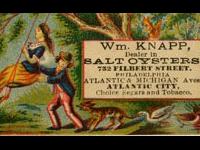Answer: Over 200 recipes.
With improvised recipes and small rations, Civil War cuisine was far from appetizing, but it was essential for the survival of troops on both sides. Rations, which included salted or smoked meats along with dried or canned fruits and vegetables, were bought, stored, and distributed under the purview of the Commissary Department of both the Union and the Confederacy. Soldiers often ate a simple biscuit made of flour, water, salt, and fat. Officially called hardtack, these tough, flat rations were nicknamed “tooth dullers,” or “sheet iron crackers.” While naval blockades prohibited the importation of goods from South America, soldiers brewed acorns, charred sweet potatoes or green peas, and okra seeds as substitutes for coffee beans.
Away from the front lines of battle, 19th century households also had to make do. Mrs. Ellen Emlen, a Philadelphia housewife, compiled a cookbook of over 200 recipes in 1865, just at the end of the Civil War. She organized her cookbook into thirteen categories of recipes including meats, vegetables, sauces, food for the sick, and desserts. The section titled “Medicines” includes instructions for earache, toothache, lip salve and cold cream. Another chapter labeled “Sundries” holds recipes for carriage varnish, homemade soap, red wash for bricks, and “Liquid for the Teeth.”
The original manuscript of Ellen Emlen’s cookbook can be found at the Historical Society of Pennsylvania in the Markoe and Emlen families’ correspondence (#2071). The collection also contains miscellaneous correspondence between Ellen Emlen and her mother, Hitty Markoe.
A facsimile of Ellen Emlen’s cookbook has been recently published by the Historical Society of Pennsylvania. Partially sponsored by Tom and Cynthia Moran, this is limited edition of only 500 copies is a must for any culinary historian, civil war buff, or foodie who wants to discover wonderful historical tips and tricks and enjoy Mrs. Emlen’s comments about different recipes. This is not simply a how-to book—it is a peek into the American past and into one woman’s attempt to preserve her knowledge. This single volume documents years of Mrs. Emlen’s trial and error as she developed delicious edible and household recipes.
Books may be ordered online at www.hsp.org or purchased at the reception desk of HSP at 1300 Locust St., Philadelphia.
Image: “Bugbee’s Ladies’ and Gents’ Oyster and Refreshment Saloon” and “Wm. Knapp, Salt Oysters,” trade cards (circa 1880), HSP trade card collection (Collection 3138), The Historical Society of Pennsylvania.

